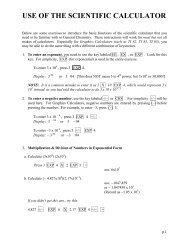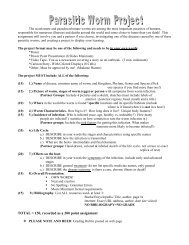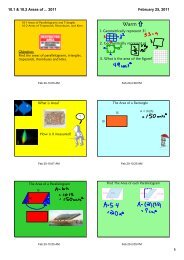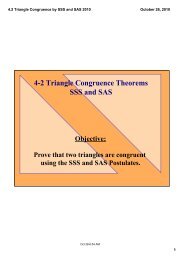Batteries and Electrolytic Cells PowerPoint (pdf)
Batteries and Electrolytic Cells PowerPoint (pdf)
Batteries and Electrolytic Cells PowerPoint (pdf)
You also want an ePaper? Increase the reach of your titles
YUMPU automatically turns print PDFs into web optimized ePapers that Google loves.
BATTERIES AND ELECTROLYTIC<br />
CELLS<br />
Practical Electrochemistry
How <strong>Batteries</strong> Work<br />
• One of the most practical<br />
applications of spontaneous redox<br />
reactions is making batteries.<br />
• In a battery, a spontaneous<br />
electron transfer from a reducer to<br />
an oxidizer is forced to occur<br />
through an external wire.<br />
• As the electrons crowd through<br />
the wire, they give up their energy<br />
to do work.
Spontaneous Electron Transfer<br />
• Zinc atoms will give up their 2<br />
valence electrons to copper ions<br />
easily.<br />
2+<br />
Zn<br />
Cu 0 (s)<br />
Cu 2+
Remote Transfer<br />
• If a barrier is placed between Zn <strong>and</strong><br />
Cu 2+ , the transfer can still take place,<br />
but through a wire.<br />
Zn
Electrochemical <strong>Cells</strong><br />
• Electrochemical cells are those in<br />
which spontaneous electron<br />
transfer takes place through a<br />
wire.<br />
• They are also called voltaic or<br />
galvanic cells.<br />
• You probably know them best by<br />
their practical name: batteries.<br />
• We think of batteries as electrical,<br />
but they are really chemical<br />
devices that produce electricity.
<strong>Batteries</strong><br />
• <strong>Batteries</strong> are really quite simple<br />
devices that contain 2 half-cells<br />
with electrodes <strong>and</strong> solutions.<br />
• Each half-cell is usually made of a<br />
metal electrode <strong>and</strong> a solution<br />
containing a salt of the same<br />
metal.<br />
• There is an external wire<br />
connecting the 2 electrodes.<br />
• The electrodes are the negative<br />
anode <strong>and</strong> the positive cathode.
<strong>Batteries</strong><br />
• An electrical power using device<br />
(resistor) is placed in the wire, <strong>and</strong><br />
as the electrons crowd through the<br />
device, they give up their energy<br />
to make it operate: ex, a light bulb<br />
in a flashlight.<br />
• The circuit must however be<br />
complete for electrons to flow, so<br />
a salt bridge or porous barrier<br />
between half-cells is also<br />
necessary.
Basic Battery<br />
Zinc metal<br />
atoms with 2<br />
electrons<br />
Copper<br />
atoms with 2<br />
electrons<br />
Zn 2+<br />
aqueous<br />
ions<br />
2+<br />
Cl-<br />
2+<br />
Hungry Cu<br />
2+ ions<br />
Cl-<br />
Zn<br />
Cu<br />
Anions move<br />
across the<br />
2+ Cl- Cl-<br />
barrier to<br />
Cl-<br />
Cl-<br />
complete the<br />
circuit.<br />
Anode half-cell (-) Cathode half-cell (+)<br />
Zn Zn 2+ + 2e - Cu 2+ + 2 e - Cu
Disclaimer<br />
• Unlike the animations, electrons<br />
do not really “zip” through a wire<br />
from one end to the other.<br />
• It’s actually more like a tube full of<br />
ping-pong balls.<br />
• If you push a new ball into one<br />
end, they all move down a little,<br />
<strong>and</strong> the one on the other end pops<br />
out.<br />
• Electrons in a real electric circuit<br />
actually move quite slowly.
Basic Battery<br />
• The anode is slowly dissolving<br />
away as the atoms become<br />
soluble ions.<br />
• The cations of the cathode<br />
compartment are becoming metal<br />
atoms, so the cathode is getting<br />
more massive.<br />
• When either the anode is<br />
completely gone or the cathode<br />
cations are gone, the battery is<br />
dead.
Why batteries die on the shelf<br />
2+<br />
2+<br />
Cl-<br />
Cl-<br />
Cl-<br />
Cl-<br />
- Cl- +<br />
Zn<br />
Cu<br />
Cl-<br />
All the energy is released as heat <strong>and</strong> no work is<br />
done. However, the barrier must be porous for the<br />
battery to function normally.
Rechargeable <strong>Batteries</strong><br />
Zn<br />
2+<br />
2+<br />
Generator:<br />
electron pump<br />
Cl-<br />
2+<br />
Cl-<br />
Cl-<br />
Cl-<br />
Cu<br />
Cl-<br />
Cl-<br />
Cl-<br />
Cl-<br />
With a<br />
rechargeable<br />
battery, a<br />
generator pushes<br />
the electrons<br />
backwards in the<br />
circuit.<br />
Even though the<br />
electrons don’t<br />
“want” to go in<br />
this direction,<br />
the generator<br />
forces them.<br />
The electrons<br />
are restored to<br />
the anode <strong>and</strong><br />
the battery can<br />
be used again.
Electromotive Force (emf)<br />
• What is electromotive force?<br />
• Emf is symbolized E°.<br />
• It is the “pressure” with which<br />
electrons flow through a circuit.<br />
• Emf is measured in volts.<br />
• So, how does one go about<br />
measuring the voltage produced<br />
by a battery?<br />
• Or, are all batteries the same<br />
except for size?
Half-Cell Potentials<br />
• Years ago, scientists agreed on a<br />
st<strong>and</strong>ard reference half-cell, against<br />
which to measure all other halfreactions.<br />
• The reference they chose was a halfcell<br />
with H + in the solution, <strong>and</strong> a<br />
platinum electrode.<br />
• The reaction occurring in the cell is:<br />
2H + (aq) + 2 e - H 2 (g)<br />
• Hydrogen ions are reduced.<br />
• (The Pt is an inert electrode.)
Half-Cell Potentials<br />
• The hydrogen half-cell was assigned a<br />
voltage of E° = 0.0Volts.<br />
• Various reactions were used for the<br />
other half-cell <strong>and</strong> the voltages<br />
recorded.<br />
• If an element is easier to reduce than<br />
hydrogen, the voltage is a positive<br />
value.<br />
• For example, when the hydrogen half<br />
cell is hooked up to a copper half-cell,<br />
the voltage is +0.34V.
Half-Cell Potentials<br />
• So, a copper/hydrogen battery has<br />
an overall voltage (E° cell ) of +0.34<br />
volts.<br />
• If the element is more difficult to<br />
reduce than hydrogen, the<br />
recorded voltage is negative.<br />
• Ex. Cr 3+ + 3e - Cr E° = -0.74V<br />
• All such half-cell voltages are<br />
recorded in a table of St<strong>and</strong>ard<br />
Electrode Reduction Potentials.
St<strong>and</strong>ard Reduction Potentials<br />
Reduction Half-Reaction E°<br />
F 2 + 2e - 2 F -<br />
+2.87V<br />
Au 3+ + 3e - Au<br />
+1.42V<br />
Ag + + e - Ag<br />
+0.80V<br />
I 2 + 2e - 2I -<br />
+0.54V<br />
Cu 2+ + 2e - Cu<br />
+0.34V<br />
2 H + + 2 e - H 2 (g) 0.0 0V<br />
Pb 2+ + 2e - Pb<br />
-0.13V<br />
Ni 2+ + 2e - Ni<br />
-0.28V<br />
Cd 2+ + 2e - Cd<br />
-0.41V<br />
Zn 2+ + 2e - Zn<br />
-0.76V<br />
Li + + e - Li<br />
-3.04V
Battery Voltages<br />
• In order for an electrochemical cell<br />
to work as a battery, the overall<br />
cell voltage must be positive.<br />
• Remember that a reduction cannot<br />
occur without an oxidation.<br />
• The table we just saw shows only<br />
reductions.<br />
• So, one of the half-cell reactions<br />
will need to be turned around to<br />
become an oxidation.
Battery Voltages<br />
• Guess what happens to the<br />
symbol on the voltage if we turn<br />
the equation around.<br />
• The +/- symbol changes!<br />
• Let’s examine our Cu/Zn battery<br />
again with a look at the voltage it<br />
generates.
Cu/Zn Battery<br />
• Here are the 2 half-reactions from<br />
the table:<br />
• Cu 2+ + 2e - Cu +0.34V<br />
• Zn 2+ + 2e - Zn -0.76V<br />
• One of the reactions will have to be<br />
turned around to show an oxidation.<br />
• Which one will it be to leave a positive<br />
voltage?<br />
• Right! The Zn reaction must be<br />
reversed.
Cu/Zn Battery<br />
• Cu 2+ + 2e - Cu<br />
• Zn Zn 2+ + 2e -<br />
+0.34V<br />
+0.76V<br />
• Notice that the voltage became<br />
positive.<br />
• To calculate battery voltage, simply<br />
add the 2 equations together.<br />
• Cu 2+ + 2e - Cu +0.34V<br />
• Zn Zn 2+ + 2e - +0.76V<br />
• Cu 2+ + Zn Zn 2+ + Cu +1.10V
Battery Electrodes<br />
• In an earlier slide, we said that a<br />
battery has an anode <strong>and</strong> a<br />
cathode.<br />
• How can you tell which is which?<br />
• Do you know the legend of Paul<br />
Bunyan?<br />
• Paul, the giant lumberjack had a<br />
well known pet: Babe, the blue ox.<br />
• But Paul had another, less famous<br />
pet: Fritz, the red cat.
Battery Electrodes<br />
• So, when you think of<br />
batteries, think of Paul<br />
Bunyan.<br />
• He had 2 pets: an ox <strong>and</strong><br />
a red cat.<br />
• The anode is where<br />
oxidation happens, <strong>and</strong><br />
reduction is at the<br />
cathode.<br />
• The cathode is the +<br />
electrode, <strong>and</strong> the anode<br />
is the – electrode.<br />
• Electron flow is always<br />
from anode to cathode.
Try This Example<br />
• A battery is composed of a silver<br />
half-cell <strong>and</strong> a cadmium half-cell.<br />
• Write the reduction <strong>and</strong> oxidation<br />
half reactions.<br />
• Draw the battery.<br />
• Calculate the voltage.<br />
• Label the anode <strong>and</strong> cathode.<br />
• Draw the direction of electron flow.
Silver-Cadmium Battery<br />
e - flow:<br />
Cd to Ag<br />
Cd is<br />
oxidized:<br />
anode<br />
Ag is<br />
reduced:<br />
cathode<br />
Put in the porous<br />
barrier.<br />
Add the<br />
electrodes.<br />
Ag Cd Put cations in<br />
Anode the solution.<br />
-<br />
Ag + Cd 2+ We also need<br />
some anions.<br />
Cathode<br />
+<br />
Write half-reactions <strong>and</strong> voltages.<br />
Ag + + e - Ag E° = 0.80V<br />
Cd Cd 2+ Cd + 2e 2+ - + 2eCd<br />
-<br />
E° = +0.41V -0.41V<br />
Total Voltage = 1.21V<br />
Connect the<br />
external circuit.<br />
Reverse the Cd<br />
equation to be<br />
an oxidation.
Alternate Battery Diagrams<br />
• Sometimes a simple battery<br />
diagram is shown as 2 separate<br />
half-cells. Instead of a porous<br />
barrier, there is a “salt bridge.”<br />
The bridge is<br />
usually some sort<br />
of tube that is<br />
filled with salt<br />
solution. It allows<br />
transfer of ions<br />
from one half-cell<br />
to the other.
Electrolysis<br />
• Electrolysis involves using electric<br />
current <strong>and</strong> energy to force a nonspontaneous<br />
redox reaction to go.<br />
• It is the opposite of an<br />
electrochemical cell.<br />
• So, the overall cell voltage (E°) is<br />
negative rather than positive.<br />
• This is the minimum voltage<br />
needed to make the cell operate.
Electrolysis<br />
• The rechargeable battery we saw<br />
earlier is an example of an<br />
electrolytic reaction.<br />
• We use a direct current generator<br />
for force the electron flow to go in<br />
reverse.<br />
• Electrolysis is also used<br />
extensively for electroplating one<br />
metal onto another.
<strong>Electrolytic</strong> Cell Example<br />
• An easy example of an electrolysis<br />
reaction would be the<br />
decomposition of NaCl.<br />
• First the NaCl must be melted<br />
(around 1500°C).<br />
• Then inert metal electrodes are<br />
placed in the liquid <strong>and</strong> the current<br />
is turned on.<br />
• An electron is removed from Cl -<br />
<strong>and</strong> transferred to Na + .
<strong>Electrolytic</strong> Cell Example<br />
+ Na + ion<br />
Na atom<br />
At the anode, Cl - ions lose<br />
electrons <strong>and</strong> are oxidized<br />
to Cl 2<br />
molecules.<br />
- Cl - ion electrons<br />
Cl atom<br />
Electrons still flow<br />
from anode to<br />
cathode.<br />
At the cathode, Na +<br />
ions are reduced to<br />
Na atoms.<br />
+<br />
- +<br />
-<br />
A<br />
-<br />
+ C
<strong>Electrolytic</strong> Cell<br />
• The key differences<br />
between the<br />
electrolytic cell <strong>and</strong><br />
the electrochemical<br />
cell are:<br />
1. Generator rather<br />
than a resistor in the<br />
circuit.<br />
2. Lack of a porous<br />
barrier or salt bridge.<br />
3. Polarities of the<br />
electrodes are<br />
reversed. The<br />
anode is positive<br />
<strong>and</strong> the cathode is<br />
negative.<br />
+<br />
- +<br />
-<br />
A<br />
-<br />
+ C
Aluminum Production<br />
• Another very important industrial<br />
electrolysis reaction is the Hall-<br />
Heroult process for making<br />
aluminum from bauxite ore.<br />
• Al 2 O 3 (l) + 3 C(s) 2 Al(l) + 3 CO(g)<br />
• Al 3+ + 3 e - Al metal (reduction)<br />
• C(s) + O CO (oxidation of C)<br />
• The production of aluminum metal<br />
takes about 1% of all the electricity<br />
used in the U. S. each year.
Aluminum Production<br />
• Although aluminum is relatively<br />
inexpensive, (about $1.50-$2.00<br />
per pound), it is MUCH cheaper to<br />
melt <strong>and</strong> recycle aluminum than it<br />
is to smelt new metal.<br />
• In the early 1800’s, when only a<br />
small amount of metal could be<br />
produced, Al cost $250,000 per<br />
pound ($545/gram) while silver<br />
was only $17/gram!
Calculating Voltage<br />
• Voltage for electrolytic cells is<br />
calculated the same way that it is<br />
for batteries, except that the value<br />
will be negative rather than<br />
positive for this non-spontaneous<br />
cell.<br />
• 2Cl - Cl 2 + 2 e - E° = -1.36V<br />
• 2Na + + 2 e - 2Na E° = -2.71V<br />
• Total voltage: E° cell = -4.07V<br />
• 4.07V is the minimum voltage<br />
needed to decompose NaCl(l).
Uses for Electrolysis<br />
• Electrolysis of seawater is used to<br />
make Cl 2 , H 2 <strong>and</strong> NaOH, three<br />
very useful <strong>and</strong> important<br />
materials.<br />
• Electrolysis is also used<br />
extensively for electroplating one<br />
metal onto another (sometimes<br />
called ‘anodizing.’)<br />
• For example ‘silver’ flatware is<br />
really silver plated flatware.
Electroplating<br />
• Silverware is not solid silver.<br />
• It is made of some cheaper,<br />
harder metal, like nickel.<br />
• Then the nickel piece is coated<br />
with silver in an electrolysis cell.<br />
• A bar of solid silver acts as the<br />
anode, <strong>and</strong> the nickel piece is the<br />
cathode.<br />
• The cell simply transfers silver<br />
atoms from anode to cathode.
Electroplating<br />
Silver bar anode:<br />
Ag atoms change<br />
to ions <strong>and</strong><br />
dissolve into the<br />
solution.<br />
e -<br />
The generator pulls<br />
electrons from the<br />
anode <strong>and</strong> pushes<br />
them into the<br />
cathode.<br />
e -<br />
e -<br />
e -<br />
e -<br />
e - e - e -<br />
e -<br />
Knife <strong>and</strong><br />
threek<br />
cathode: Ag +<br />
ions change<br />
back to atoms<br />
<strong>and</strong> stick to, or<br />
plate the<br />
metal.<br />
Ag +<br />
Ag<br />
anode<br />
Ag<br />
AgNO 3<br />
(aq)
Schematic Symbols<br />
• Here are some symbols commonly<br />
used in electronic schematics:<br />
• Generator<br />
• Resistor<br />
• Battery<br />
• Voltmeter<br />
V<br />
• Ammeter A<br />
• Switch

















